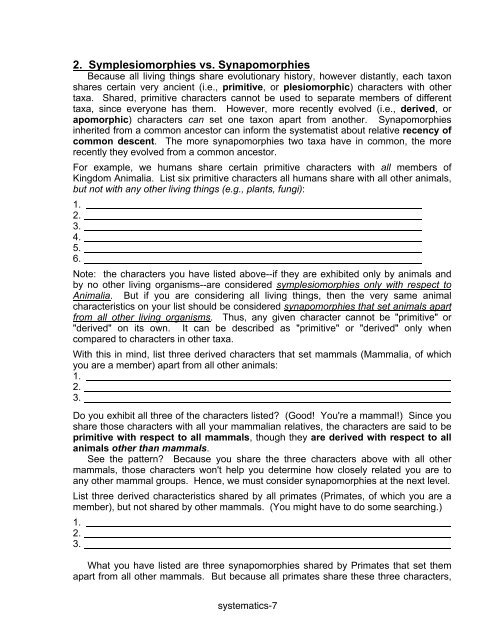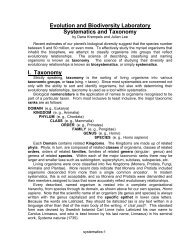II. <strong>Systematics</strong>Because new data constantly change our underst<strong>and</strong>ing of evolutionaryrelationships, classifications are constantly updated <strong>and</strong> changed. The goal of mostmodern systematists is to construct monophyletic taxa, which reflect true evolutionaryrelationships by including all descendants of a single common ancestor. Severaldifferent lines of evidence can be used to determine the degree of common ancestrybetween two taxa, including comparison of morphology (at many levels, includingcellular), nucleic acid sequence, protein sequence, embryo development, etc. As newtechnologies arise, our ability to study evolutionary relationships evolves.A. Reconstructing PhylogeniesA phylogeny is a history of the evolutionary descent of extant (i.e., presently living)or extinct (i.e., no longer living) taxa from ancestral forms. To date, about 1.4 millionspecies (including 750,000 insects, 250,000 plants <strong>and</strong> 41,000 vertebrates) of the 5 to50 million on earth have been scientifically described <strong>and</strong> classified.What is a species? Although biologists still debate the precise definition, we shalluse the biological definition of a species as a group of actually or potentiallyinterbreeding natural populations which are reproductively isolated from othersuch groups. More simply, two organisms can be considered members of the samespecies if they can breed <strong>and</strong> produce fertile, viable offspring under natural conditions.1. Primitive vs. Derived CharactersEver since Darwin's publication of On the Origin of Species by Means of NaturalSelection, the scientific community has labored to underst<strong>and</strong> how different speciesarise. We know that extant species evolved from previously existing ancestralspecies, <strong>and</strong> that this may involve descent with modification of traits (= characters)from one generation to the next. A character that shows little or no change from thesame character in an ancestor is said to be primitive, whereas one that has changed inappearance <strong>and</strong>/or function relative to the ancestral form is derived.A primitive character is also known as a plesiomorphy; a primitive character sharedbetween two or more taxa is known as a symplesiomorphy (literally "shared primitivecharacter"). A derived character is also known as an apomorphy; a derived charactershared between two or more taxa is known as a synapomorphy (literally "sharedderived character").All living things share these most basic symplesiomorphies:1. Organization of structure (anatomy)2. Capacity to generate more organisms like themselves (reproduction)3. Growth <strong>and</strong> development4. Ability to utilize energy to do work (metabolism)5. Response to environmental stimuli (reaction)6. Regulatory mechanisms to keep the internal environment within tolerable limits(homeostasis)7. Populations that change in gene composition over time (evolution)In classifying an unknown organism," the systematist must consider characters thatmake that organism unique <strong>and</strong> different from members of other species. To achievethis end, derived characters are the most informative ones to use. The next sectionexplains why.systematics-6
2. Symplesiomorphies vs. SynapomorphiesBecause all living things share evolutionary history, however distantly, each taxonshares certain very ancient (i.e., primitive, or plesiomorphic) characters with othertaxa. Shared, primitive characters cannot be used to separate members of differenttaxa, since everyone has them. However, more recently evolved (i.e., derived, orapomorphic) characters can set one taxon apart from another. Synapomorphiesinherited from a common ancestor can inform the systematist about relative recency ofcommon descent. The more synapomorphies two taxa have in common, the morerecently they evolved from a common ancestor.For example, we humans share certain primitive characters with all members ofKingdom Animalia. List six primitive characters all humans share with all other animals,but not with any other living things (e.g., plants, fungi):1.2.3.4.5.6.Note: the characters you have listed above--if they are exhibited only by animals <strong>and</strong>by no other living organisms--are considered symplesiomorphies only with respect toAnimalia. But if you are considering all living things, then the very same animalcharacteristics on your list should be considered synapomorphies that set animals apartfrom all other living organisms. Thus, any given character cannot be "primitive" or"derived" on its own. It can be described as "primitive" or "derived" only whencompared to characters in other taxa.With this in mind, list three derived characters that set mammals (Mammalia, of whichyou are a member) apart from all other animals:1.2.3.Do you exhibit all three of the characters listed? (Good! You're a mammal!) Since youshare those characters with all your mammalian relatives, the characters are said to beprimitive with respect to all mammals, though they are derived with respect to allanimals other than mammals.See the pattern? Because you share the three characters above with all othermammals, those characters won't help you determine how closely related you are toany other mammal groups. Hence, we must consider synapomorphies at the next level.List three derived characteristics shared by all primates (Primates, of which you are amember), but not shared by other mammals. (You might have to do some searching.)1.2.3.What you have listed are three synapomorphies shared by Primates that set themapart from all other mammals. But because all primates share these three characters,systematics-7

















